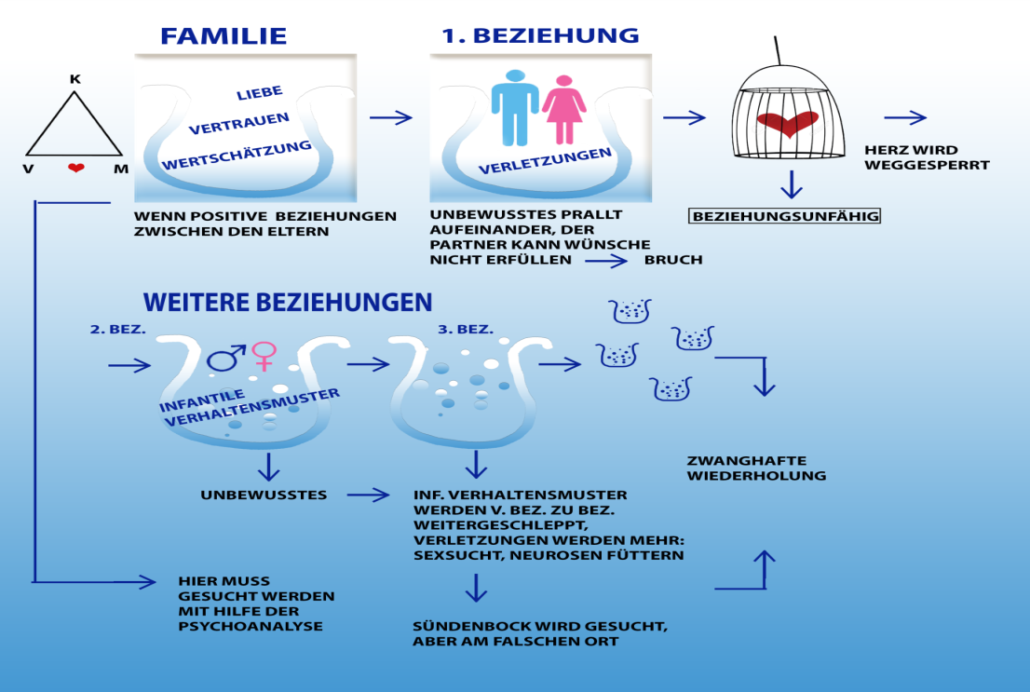Our world can be beautiful
Own source Andrawis A, (2008).
The child’s first impression of a family relationship
Fig. 1 taken from own source: Andrawis A, (2018).
As the author has mentioned, this is the child’s first impression of family relationship. It is a process that takes place in connection with life, from the early oedipal phase to adulthood. In one’s own relationship it depends on which experiences shape the child, which impressions in a positive or negative sense contribute to the failure or success of the relationship (ibid.).
First impression of the child
The first relationship for a child is the family relationship, consisting of father, mother and children. A child gains a first impression of how a relationship works through the parental relationship. They see how parents deal with conflicts or how they show affection. From these impressions, the child learns how relationships work.
However, we know that everyday stresses have an impact on family life, and both parents usually work. In Andrawis A, (2018) it leads to the child having to be cared for outside the home. The parents are overtaxed by psychosocial components, which puts a strain on family life. This accumulates conflicts, stress, imbalance and dysfunctionality of harmony. Parents, under the influence of their own repressed traumas, subsequently experience projections within family life. This manifests itself in forms of neurotic transmission phenomena, resulting in destructive infantile behavior patterns of the unconscious and counter-transmission phenomena.
Thus, quarrels and ambivalent feelings develop and again negative impressions of the child. It is possible that the child feels guilty about this escalation and develops feelings of guilt itself. This situation often persists until puberty. Afterwards the young people want to leave their parents’ house and create their own life as well as lead their own relationship (ibid.).
Second relationship – relationships after puberty
“On their own way in search of the ideal father-mother pictures, as well as primeval love and trust, the expectations of the young people are very high. The desire for an ideal form of relationship is the focus” Andrawis, (2018). Now it should not be forgotten that the current couple’s relationship is facing tough conditions. “Both are filled with early repressions and traumas. The negative impressions gained through parenting lead to one’s own strict relationship patterns, colored by fear of failure.
In a broader sense, projections of the suppressed unconscious appear, making it more difficult for one person to live together and thus running the risk of failing in relationships.
The ideal mother and father figures are neither fulfilled nor found. The accumulated stress, the excessive demands and the renewed projections lead to a failure of the relationships, because the ideal expectation of this relationship and the expectations of the great love cannot be fulfilled. The relationship is doomed to failure. The once again negative experience leads to disappointment, injuries and loss of love and “heartache”. The young people confine their hearts and divisions occur (ibid.).
Third relationship – relationships in adulthood
In adulthood people are again looking for the ideal partner and a way out of lovesickness and heartache. In the relationship, it can happen that one of the partners cannot get involved due to fears of loss. The collection of traumas from the family of origin, as well as injuries and disappointments from one’s own relationships and destructive-infantile behaviour patterns, accompanied by mutual projections, lead to dysfunctionality of harmony, communication deficits and unfulfilled expectations.
In addition, there are deficits in natural sexuality/genitality. Biological sexuality is to be understood as the totality of the expression of life like emotions and interactions in the interpersonal relationship under consideration of social, cultural and psychological factors. For comparison, genitality is to be understood as orgasmic mutual satisfaction, end act of sexuality.
Without the ability to engage with the other, a relationship is doomed to failure (ibid.).
Fourth Relationship – Relationships in High Adulthood
At this stage of the relationship, a ritual of frequent partner change is integrated. There are more and more unconscious projections. The experiences from previous relationships are subject to comparison in terms of sexuality and character traits. Infantile destructive behavior patterns are dragged on.
Fifth Relationship – Further Relationships
Accustomed to the ritual of frequently changing partners, there is a behaviour of “nibbling with your eyes”, secret squinting at possible partners and, subsequently, genitality and sex addiction. The relationship is not enough for the partner. One is on the lookout for unfulfilled primeval love, basic trust and ideal father and mother images. As Andrawis (2018) described it as a metaphor.
As Andrawis, (2018) has described as a metaphor: “On the journey through life in search of what Floren true, so to speak the Floren primeval love, and clock trust, and the question of how to turn over again…”!
During the journey of life
“During your life’s journey in search of a fulfilled partnership, you repeatedly encounter disappointments of not finding an ideal partner. In reality, one unconsciously searched for “Floren’s primal love, watch trust and the ideal father and mother figure” (ibid.).
Primordial love and trust, as already mentioned above. On the path of the search and the ritual of the further search there are compulsive repetitions of the change of partner, sexuality and genitality. This ritual search can be described as an addiction that manifests itself in pathological symptoms. It is a fact that no one wants to consciously torture himself or his partner or burden them with guilt and ambivalent behaviour. Everyone wants an ideal relationship, open, honest and sustainable towards the partner. Unfortunately, this cannot be fulfilled because all infantile-destructive, unconscious behavior patterns influence consciousness. This means that one always wants to do good, but is exactly in paradox.
With Paul in, “I know that nothing good dwells in me, that is, in my flesh; will is with me, but I cannot do good. For I do not do the good that I want, but the evil that I do not want. But if I do what I do not want, then I am no longer the one who does so, but the sin dwelling in me…that evil exists in me, although I want to do good…another law in my members, which is at odds with the law of my reason and keeps me imprisoned in the law of sin, which governs my members. I am an unhappy man! Who will…? (NT.Rom.7:18-25 p.1637)
As Paul emphasizes, in our physical-psychic condition (flesh of no good dwells) from a psychoanalytical point of view, I point to the destructive infantile behavior patterns of the unconscious and their negative influence on interpersonal relationships. This means that evil dwells in our body. In reality, everyone wants to do good, but unfortunately does not succeed. Against my will, the repressed unconscious has an influence on my actions. My reason argues with my destructive behaviour, because I do not succeed in doing good, but evil. So far this
Dispute between my reason and my repressed traumas, because I did not succeed in doing the good according to my reason to such an extent that I suffer from the symptom of guilt.
The unconscious and its influence on the pattern of behavior apply not only to saints, but also to all of us.
Reasons why we fail in harmonious relationships are based on the facts of projections and unsolvable partner conflicts, feelings of guilt and depression. Usually one looks for a so-called scapegoat for one’s own unfulfilled love life through the representation of foreign objects. The term “foreign object representation” contains the word object (that is the relationship between the child, mother, breast and mother) and comes from the experience of the object relationship of early childhood traumas. These are the basic evils for separations and divorces, as well as serious social conflicts (ebd.).
Univ. Prof. Dr. Andrawis



